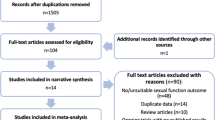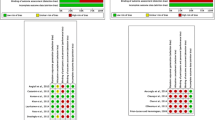Abstract
Purpose of Review
In this review, the current literature available to patients and providers of female pelvic medicine interventions will be addressed. Topics include stress urinary incontinence, pelvic organ prolapse, urgency urinary incontinence, and upcoming data on mixed incontinence.
Recent Findings
There are multiple randomized control trials recently published that have advanced the field of female pelvic medicine by answering questions regarding treatment in a systematic way.
Summary
Although there is more evidence available for female pelvic medicine interventions, there is still improvement needed in the quality of trials performed.
Similar content being viewed by others
References
Papers of particular interest, published recently, have been highlighted as: • Of importance •• Of major importance
Nygaard I, Barber MD, Burgio KL, et al. Prevalence of symptomatic pelvic floor disorders in US women. JAMA. 2008;300(11):1311–1316. doi:10.1001/jama.300.11.1311.
Moher D, Hopewell S, Schulz KF, Montori V, Gøtzsche PC, Devereaux PJ. CONSORT 2010 explanation and elaboration: updated guidelines for reporting parallel group randomised trials. BMJ British Med J Publ Group. 2010;340(15):c869. http://www.ncbi.nlm.nih.gov/pubmed/20332511.
Koch M, Riss P, Umek W, Hanzal E. CONSORT and the internal validity of randomized controlled trials in Female Pelvic Medicine. Neurourol Urodyn. 2015. doi:10.1002/nau.22811.
Koch M, Riss P, Umek W, Hanzal E. The explicit mentioning of reporting guidelines in urogynecology journals in 2013: a bibliometric study. Neurourol Urodyn 2016;35(3):412–6. doi:10.1002/nau.22726/full.
Cavadas V, Branco F, Carvalho FL, Osório L, Gomes MJ, Silva-Ramos M. The quality of reporting of randomized controlled trials in pelvic organ prolapse. Int Urogynecol J Springer-Verlag. 2011;22(9):1117–25. doi:10.1007/s00192-011-1426-z/fulltext.html.
•• Richter HE, Burgio KL, Brubaker L, Nygaard IE, Ye W, Weidner A. Continence pessary compared with behavioral therapy or combined therapy for stress incontinence: a randomized controlled trial. Obstet Gynecol NIH Publ Access. 2010;115(3):609–17. ATLAS trial showed value of conservative therapy.
•• Nager CW, Brubaker L, Litman HJ, Zyczynski HM, Varner RE, Amundsen C. A randomized trial of urodynamic testing before stress-incontinence surgery. N Engl J Med Massachusetts Med Soc. 2012;366(21):1987–97. doi:10.1056/,DanaInfo=proxy.library.upenn.edu,Port=2648+NEJMoa1113595. VALUE trial allowed decreased use of urodynamcis for women who did not need it.
•• Richter HE, Albo ME, Zyczynski HM, Kenton K, Norton PA, Sirls LT. Retropubic versus transobturator midurethral slings for stress incontinence. N Engl J Med Massachusetts Med Soc. 2010;362(22):2066–76. Trial of Mid Urethral Slings (TOMUS) compared transobturator and retropubic slings.
Laurikainen E, Valpas A, Aukee P, Kivelä A, Rinne K, Takala T, et al. Five-year results of a randomized trial comparing retropubic and transobturator midurethral slings for stress incontinence. Eur Urol. 2014;65(6):1109–14.
•• Labrie J, Berghmans BLCM, Fischer K, Milani AL, van der Wijk I, Smalbraak DJC. Surgery versus physiotherapy for stress urinary incontinence. N Engl J Med Massachusetts Med Soc. 2013;369(12):1124–33. doi:10.1056/,DanaInfo=proxy.library.upenn.edu,Port=2648+NEJMoa1210627. This trial compared conservative therapy vs surgery for SUI.
Ford AA, Rogerson L, Cody JD, Ogah J. Mid-urethral sling operations for stress urinary incontinence in women. In: Ogah J, editor. Cochrane database of systematic reviews. Chichester: Wiley; 2015.
Smith FJ, Holman CDJ, Moorin RE, Tsokos N. Lifetime risk of undergoing surgery for pelvic organ prolapse. Obstet Gynecol. 2010;116(5):1096–100. http://www.ncbi.nlm.nih.gov/pubmed/20966694.
Hendrix SL, Clark A, Nygaard I, Aragaki A, Barnabei V, McTiernan A. Pelvic organ prolapse in the Women’s Health Initiative: gravity and gravidity. Am J Obstet Gynecol. 2002;186(6):1160–6.
Wiegersma M, Panman CMCR, Kollen BJ, Vermeulen KM, Schram AJ, Messelink EJ. Pelvic floor muscle training versus watchful waiting or pessary treatment for pelvic organ prolapse (POPPS): design and participant baseline characteristics of two parallel pragmatic randomized controlled trials in primary care. Maturitas. 2014;77(2):168–73. http://www.ncbi.nlm.nih.gov/pubmed/24268876.
Panman C, Wiegersma M, Kollen BJ, Berger MY, Lisman-Van Leeuwen Y, Vermeulen KM et al. Two-year effects and cost-effectiveness of pelvic floor muscle training in mild pelvic organ prolapse: a randomised controlled trial in primary care. BJOG. 2016. http://www.ncbi.nlm.nih.gov/pubmed/26996291.
•• Barber MD, Brubaker L, Burgio KL, Richter HE, Nygaard I, Weidner AC. Comparison of 2 transvaginal surgical approaches and perioperative behavioral therapy for apical vaginal prolapse: the OPTIMAL randomized trial. JAMA Am Med Assoc. 2014;311(10):1023–34. https://extranet.uphs.upenn.edu/,DanaInfo=jama.jamanetwork.com+article.aspx?articleid=1840237 . This trial compared multiple preoperative and intraoperati ve options for POP.
Alas AN, Anger JT. Management of apical pelvic organ prolapse. Curr Urol Rep Springer US. 2015;16(5):33. doi:10.1007/s11934-015-0498-6.
Nygaard I, Brubaker L, Zyczynski HM, Cundiff G, Richter H, Gantz M. Long-term outcomes following abdominal sacrocolpopexy for pelvic organ prolapse. JAMA. 2013;309(19):2016–24. doi:10.1001/jama.2013.4919.
•• Wei JT, Nygaard I, Richter HE, Nager CW, Barber MD, Kenton K. A midurethral sling to reduce incontinence after vaginal prolapse repair. N Engl J Med. 2012;366(25):2358–67. doi:10.1056/NEJMoa1111967. This trial attempted to answer the very prevalent question of fixing SUI during POP repair.
Stewart WF, Van Rooyen JB, Cundiff GW, Abrams P, Herzog AR, Corey R. Prevalence and burden of overactive bladder in the United States. World J Urol. 2003;20(6):327–36. http://www.ncbi.nlm.nih.gov/pubmed/12811491.
• Visco AG, Brubaker L, Richter HE, Nygaard I, Paraiso MFR, Menefee SA. Anticholinergic therapy vs. onabotulinumtoxinA for urgency urinary incontinence. N Engl J Med. 2012;367(19):1803–13. doi:10.1056/NEJMoa1208872. This trial compared the second- vs third-line therapy for UUI.
Amundsen CL, Richter HE, Menefee S, Vasavada S, Rahn DD, Kenton K. The refractory overactive bladder: Sacral NEuromodulation vs. BoTulinum toxin assessment: ROSETTA trial. Contemp Clin Trials. 2014;37(2):272–83. http://www.sciencedirect.com/science/article/pii/S1551714414000196.
Nager CW, Zyczynski H, Rogers RG, Barber MD, Richter HE, Visco AG et al. The design of a randomized trial of vaginal surgery for uterovaginal prolapse: vaginal hysterectomy with native tissue vault suspension versus mesh hysteropexy suspension (The Study of Uterine Prolapse Procedures Randomized Trial). Female Pelvic Med Reconstr Surg. http://www.ncbi.nlm.nih.gov/pubmed/27054798.
Eric Jelovsek J, Markland AD, Whitehead WE, Barber MD, Newman DK, Rogers RG, et al. Controlling anal incontinence in women by performing anal exercises with biofeedback or loperamide (CAPABLe) trial: design and methods. Contemp Clin Trials. 2015;44:164–74. http://www.sciencedirect.com/science/article/pii/S1551714415300677.
Sung VW, Borello-France D, Dunivan G, Gantz M, Lukacz ES, Moalli P et al. Methods for a multicenter randomized trial for mixed urinary incontinence: rationale and patient-centeredness of the ESTEEM trial. Int Urogynecol J. http://www.ncbi.nlm.nih.gov/pubmed/27287818.
Rawlings T, Zimmern PE. Economic analyses of stress urinary incontinence surgical procedures in women. Neurourol Urodyn. 2015. doi:10.1002/nau.22878/full.
Jelovsek JE, Maher C, Barber MD. Pelvic organ prolapse. Lancet. 2007;369(9566):1027–38.
Meikle SF, Plenary I. Monday plenary. J Urol Elsevier. 2016;195(4):e949–50. doi:10.1016/j.juro.2016.03.123.
Author information
Authors and Affiliations
Corresponding author
Ethics declarations
Conflict of Interest
Dr. Lamin and Dr Strother declare that they have no conflict of interest.
Dr. Smith reports grants from NIH, other Allergan, outside the submitted work.
Human and Animal Rights and Informed Consent
This article does not contain any studies with human or animal subjects performed by any of the authors.
Additional information
This article is part of the Topical Collection on Stress Incontinence and Prolapse
Rights and permissions
About this article
Cite this article
Lamin, E., Strother, M.C. & Smith, A.L. The Evidence for Female Pelvic Medicine Interventions. Curr Bladder Dysfunct Rep 12, 8–14 (2017). https://doi.org/10.1007/s11884-017-0399-2
Published:
Issue Date:
DOI: https://doi.org/10.1007/s11884-017-0399-2




